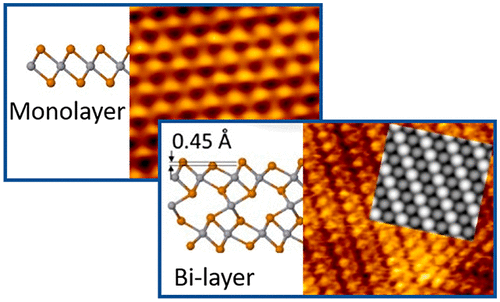Our official English website, www.x-mol.net, welcomes your feedback! (Note: you will need to create a separate account there.)
Molecular Beam Epitaxy of Transition Metal (Ti-, V-, and Cr-) Tellurides: From Monolayer Ditellurides to Multilayer Self-Intercalation Compounds.
ACS Nano ( IF 17.1 ) Pub Date : 2020-06-25 , DOI: 10.1021/acsnano.0c02712 Kinga Lasek 1 , Paula Mariel Coelho 1 , Krzysztof Zberecki 2 , Yan Xin 3 , Sadhu K Kolekar 1 , Jingfeng Li 1 , Matthias Batzill 1
ACS Nano ( IF 17.1 ) Pub Date : 2020-06-25 , DOI: 10.1021/acsnano.0c02712 Kinga Lasek 1 , Paula Mariel Coelho 1 , Krzysztof Zberecki 2 , Yan Xin 3 , Sadhu K Kolekar 1 , Jingfeng Li 1 , Matthias Batzill 1
Affiliation

|
Material growth by van der Waals epitaxy has the potential to isolate monolayer (ML) materials and synthesize ultrathin films not easily prepared by exfoliation or other growth methods. Here, the synthesis of the early transition metal (Ti, V, and Cr) tellurides by molecular beam epitaxy (MBE) in the mono- to few-layer regime is investigated. The layered ditellurides of these materials are known for their intriguing quantum- and layer dependent- properties. Here we show by a combination of in situ sample characterization and comparison with computational predictions that ML ditellurides with octahedral 1T structure are readily grown, but for multilayers, the transition metal dichalcogenide (TMDC) formation competes with self-intercalated compounds. CrTe2, a TMDC that is known to be metastable in bulk and easily decomposes into intercalation compounds, has been synthesized successfully in the ML regime at low growth temperatures. At elevated growth temperatures or for multilayers, only the intercalation compound, equivalent to a bulk Cr3Te4, could be obtained. ML VTe2 is more stable and can be synthesized at higher growth temperatures in the ML regime, but multilayers also convert to a bulk-equivalent V3Te4 compound. TiTe2 is the most stable of the TMDCs studied; nevertheless, a detailed analysis of multilayers also indicates the presence of intercalated metals. Computation suggests that the intercalation-induced distortion of the TMDC-layers is much reduced in Ti-telluride compared to V-, and Cr-telluride. This makes the identification of intercalated materials by scanning tunneling microscopy more challenging for Ti-telluride. The identification of self-intercalation compounds in MBE grown multilayer chalcogenides may explain observed lattice distortions in previously reported MBE grown early transition metal chalcogenides. On the other hand, these intercalation compounds in their ultrathin limit can be considered van der Waals materials in their own right. This class of materials is only accessible by direct growth methods but may be used as “building blocks” in MBE-grown van der Waals heterostructures. Controlling their growth is an important step for understanding and studying the properties of these materials.
中文翻译:

过渡金属(Ti,V和Cr-)碲化物的分子束外延:从单层二碲化物到多层自嵌入化合物。
通过范德华外延进行材料生长具有隔离单层(ML)材料和合成不易通过剥离或其他生长方法制备的超薄膜的潜力。在这里,研究了通过分子束外延(MBE)在单层至几层机制中合成早期过渡金属(Ti,V和Cr)碲化物的方法。这些材料的层状二碲化物因其有趣的量子和层依赖性而闻名。在这里,我们结合原位样品表征和计算预测结果进行了比较,发现具有八面体1T结构的ML二碲化物易于生长,但对于多层膜,过渡金属二卤化物(TMDC)的形成与自嵌入化合物竞争。CrTe 2已知在低生长温度下的ML模式下已成功合成了TMDC,该TMDC整体上是亚稳态的,并且容易分解为插层化合物。在升高的生长温度下或对于多层而言,仅可获得相当于本体Cr 3 Te 4的插层化合物。ML VTe 2更稳定,可以在ML方案中在更高的生长温度下合成,但是多层也可以转化为体积等效的V 3 Te 4化合物。TiTe 2是所研究的TMDC中最稳定的;然而,对多层的详细分析也表明存在嵌入金属。计算表明,与V-和Cr-碲化物相比,Ti-碲化物中TMDC层的插层诱导形变大大减少。这使得通过扫描隧道显微镜鉴定插层材料对于钛碲化物更具挑战性。在MBE生长的多层硫族化物中自我嵌入化合物的鉴定可以解释先前报道的MBE生长的早期过渡金属硫属化物中观察到的晶格畸变。另一方面,这些插层化合物在其极薄的限度内可以被认为是范德华力材料。此类材料只能通过直接生长方法获得,但可以用作MBE生长的范德华斯异质结构中的“构件”。控制它们的生长是了解和研究这些材料特性的重要步骤。
更新日期:2020-07-28
中文翻译:

过渡金属(Ti,V和Cr-)碲化物的分子束外延:从单层二碲化物到多层自嵌入化合物。
通过范德华外延进行材料生长具有隔离单层(ML)材料和合成不易通过剥离或其他生长方法制备的超薄膜的潜力。在这里,研究了通过分子束外延(MBE)在单层至几层机制中合成早期过渡金属(Ti,V和Cr)碲化物的方法。这些材料的层状二碲化物因其有趣的量子和层依赖性而闻名。在这里,我们结合原位样品表征和计算预测结果进行了比较,发现具有八面体1T结构的ML二碲化物易于生长,但对于多层膜,过渡金属二卤化物(TMDC)的形成与自嵌入化合物竞争。CrTe 2已知在低生长温度下的ML模式下已成功合成了TMDC,该TMDC整体上是亚稳态的,并且容易分解为插层化合物。在升高的生长温度下或对于多层而言,仅可获得相当于本体Cr 3 Te 4的插层化合物。ML VTe 2更稳定,可以在ML方案中在更高的生长温度下合成,但是多层也可以转化为体积等效的V 3 Te 4化合物。TiTe 2是所研究的TMDC中最稳定的;然而,对多层的详细分析也表明存在嵌入金属。计算表明,与V-和Cr-碲化物相比,Ti-碲化物中TMDC层的插层诱导形变大大减少。这使得通过扫描隧道显微镜鉴定插层材料对于钛碲化物更具挑战性。在MBE生长的多层硫族化物中自我嵌入化合物的鉴定可以解释先前报道的MBE生长的早期过渡金属硫属化物中观察到的晶格畸变。另一方面,这些插层化合物在其极薄的限度内可以被认为是范德华力材料。此类材料只能通过直接生长方法获得,但可以用作MBE生长的范德华斯异质结构中的“构件”。控制它们的生长是了解和研究这些材料特性的重要步骤。



























 京公网安备 11010802027423号
京公网安备 11010802027423号